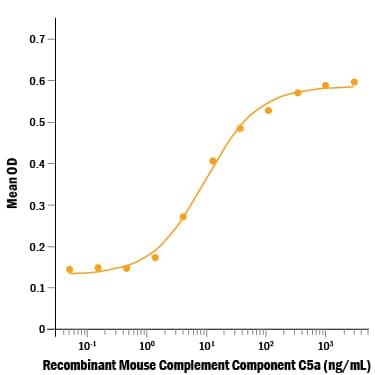Recombinant Mouse CD177 Protein, CF Summary
Product Specifications
Leu22-Ala786, with a C-terminal 6-His tag
Analysis
Customers also Viewed
Product Datasheets
Carrier Free
CF stands for Carrier Free (CF). We typically add Bovine Serum Albumin (BSA) as a carrier protein to our recombinant proteins. Adding a carrier protein enhances protein stability, increases shelf-life, and allows the recombinant protein to be stored at a more dilute concentration. The carrier free version does not contain BSA.
In general, we advise purchasing the recombinant protein with BSA for use in cell or tissue culture, or as an ELISA standard. In contrast, the carrier free protein is recommended for applications, in which the presence of BSA could interfere.
8186-CD
| Formulation | Lyophilized from a 0.2 μm filtered solution in PBS. |
| Reconstitution | Reconstitute at 100 μg/mL in PBS. |
| Shipping | The product is shipped at ambient temperature. Upon receipt, store it immediately at the temperature recommended below. |
| Stability & Storage: | Use a manual defrost freezer and avoid repeated freeze-thaw cycles.
|
Background: CD177
CD177 is a member of the uPAR/CD59/Ly6 superfamily (1). Mature mouse CD177 is a 796 amino acid (aa) protein that contains four uPAR/Ly6 domains, while human CD177 contains only two. Within common regions, mouse CD177 shares 55% and 77% aa sequence identity with human and rat CD177, respectively. CD177 is expressed on the surface of neutrophils through a glycosylphosphatidylinositol (GPI) anchor (2-4). It is nearly absent from neutrophils from paroxysmal nocturnal hemoglobinurea patients who are deficient in the ability to synthesize GPI linkages (4, 5). It is up-regulated on granulocytes from polycythemia vera and thalassemia patients (6, 7). CD177 binds to PECAM-1 on vascular endothelial cells, an interaction which mediates neutrophil adhesion to the vascular wall and neutrophil transmigration (8). It associates in cis with the Integrin MAC-1 (CD11b/CD18) (9). CD177 also associates in cis with Proteinase 3 (PR3) and is required for cell surface PR3 expression (9-11). PR3 is normally found in intracellular vesicles, but once at the cell surface it can serve as an autoimmune target for anti-neutrophil cytoplasmic antibodies (ANCA) (12). The ANCA targeting of CD177-PR3 complexes triggers neutrophil activation and vasculitis (9, 12).
- Stroncek, D.F. (2007) Curr. Opin. Hematol. 14:688.
- Skubitz, K.M. et al. (1991) J. Leukoc. Biol. 49:163.
- Kissel, K. et al. (2001) Eur. J. Immunol. 31:1301.
- Klippel, S. et al. (2002) Blood 100:2441.
- Boccuni, P. et al. (2000) Crit. Rev. Oncol. Hematol. 33:25.
- Temerinac, S. et al. (2000) Blood 95:2569.
- Zoi, K. et al. (2008) Brit. J. Haematol. 141:100.
- Sachs, U.J.H. et al. (2007) J. Biol. Chem. 282:23603.
- Jerke, U. et al. (2011) J. Biol. Chem. 286:7070.
- von Vietinghoff, S. et al. (2007) Blood 109:4487.
- Kuckleburg, C.J. et al. (2012) J. Immunol. 188:2419.
- van Timmeren, M.M. and P. Heeringa (2012) Curr. Opin. Rheumatol. 24:8.
FAQs
No product specific FAQs exist for this product, however you may
View all Proteins and Enzyme FAQsReconstitution Buffers
Reviews for Recombinant Mouse CD177 Protein, CF
There are currently no reviews for this product. Be the first to review Recombinant Mouse CD177 Protein, CF and earn rewards!
Have you used Recombinant Mouse CD177 Protein, CF?
Submit a review and receive an Amazon gift card.
$25/€18/£15/$25CAN/¥75 Yuan/¥2500 Yen for a review with an image
$10/€7/£6/$10 CAD/¥70 Yuan/¥1110 Yen for a review without an image











